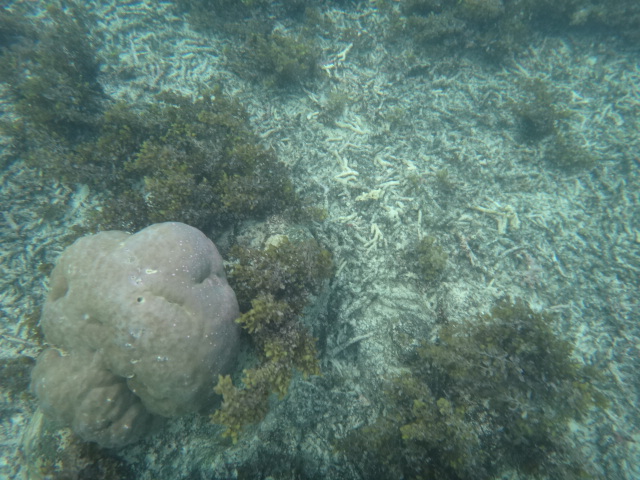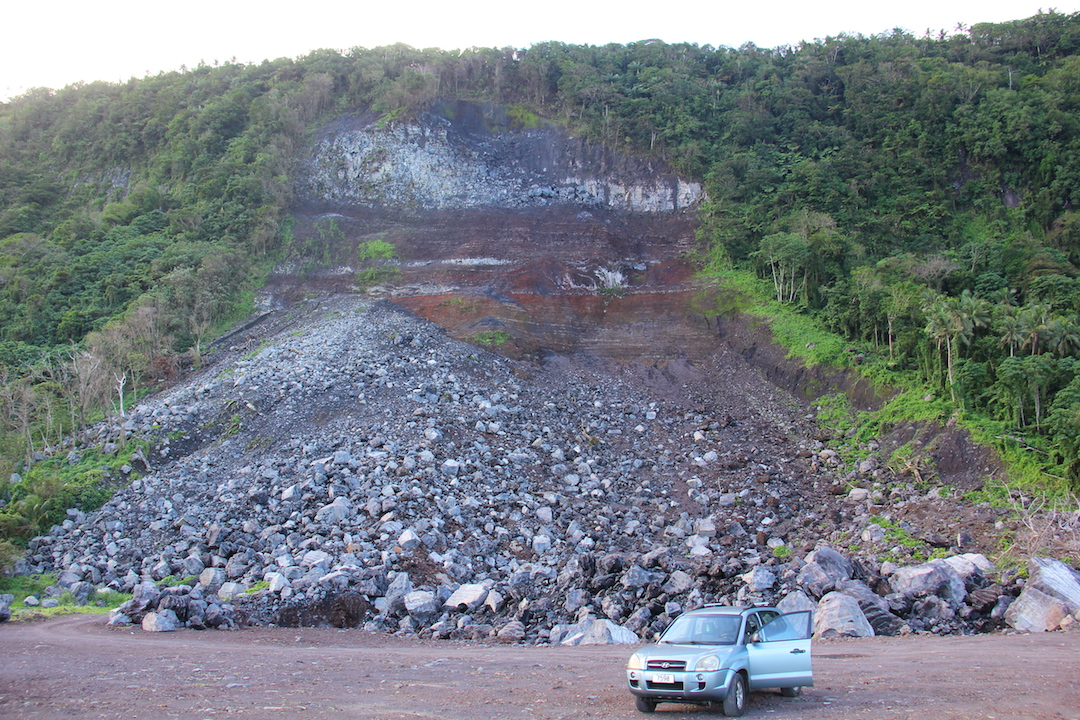
Samoa’s Climate Change Adaptation Landscape
Samoa’s Climate Change Adaptation Landscape
Churchill Exploration Fund Trip Report
July 5-July 23, 2018
Anna McGinn, Climate Change Institute and School for Policy and International Affairs, University of Maine
Anama Solofa, School for Marine Science MS ‘18, University of Maine
Samoa is a small island state in the South Pacific Ocean. On most maps, it appears as a mere speck in the vast Pacific. Yet, in the world of international climate change policy and planning, Samoa and its counterparts in the Pacific are on the frontlines—both in terms of facing climate change impacts and in conveying the gravity of this challenge to the international community. A common refrain at the United Nations Climate Change negotiations, is that ‘the small island states punch far above their weight on the issue of climate change.’ Thus, in exploring climate change adaptation efforts in Samoa, we have an opportunity to understand how this work is carried out in a country that has made climate change a national priority.
When I touched down in Samoa right on the coast of the bright blue Pacific, my University of Maine colleague, Anama Solofa, greeted me at the airport. Over the course of the next two weeks, we traversed both of Samoa’s major islands, Upolu and Savai’i, to learn about climate adaptation through the lens of the Adaptation Fund project, “Enhancing Resilience of Samoa’s Coastal Communities to Climate Change.” The Adaptation Fund is a funding mechanism under the United Nations Framework Convention on Climate Change (UNFCCC), and has been funding adaptation projects in developing countries vulnerable to climate change for the past ten years. This particular project was approved by the Adaptation Fund in 2011, and finished while I was in Samoa (July 2018). Given this timeline, my fieldwork provided an opportunity to look at a countrywide adaptation effort that has gone through the entire process of implementation.
All Adaptation Fund projects end with a terminal evaluation of the project carried out by an independent consultant in cooperation with the implementing and executing entities for the project. The second week of the terminal evaluation coincided with my first week of fieldwork, so we had the opportunity to shadow the evaluation process on Savai’i. Savai’i is home to a relatively small population compared to Upolu, and is comprised only of villages, meaning there is no city-like area. We traveled to Savai’i by ferry with the evaluation delegation, which was comprised of three representatives of the Ministry of National Resources and Environment (MNRE), one representative from the United Nations Development Programme (UNDP), and the independent consultant. The goal of the evaluation was to show the independent consultant a representative sample of project sites, and to speak with a village representative who was involved in some part of each project process.
The Adaptation Fund project funded initiatives that span from nature-based solutions like replanting mangroves and reforesting water catchment areas to engineering projects such as bridges, roads, and wave breaks. The project also served to improve inland services to facilitate inland migration, which I describe in this blog post. Link: http://umainespia.blogspot.com/2018/07/climate-change-adaptation-in-samoa.html
One of the major initiatives we visited was the wave break project. The project site was determined by identifying an area of the island that was facing rapid coastal erosion. There were a number of possible locations, but all coastal landowners declined the project except one located in the village of Manase. This particular family owns beachside accommodations for tourists, and had seen two rows of their beachfront fales (huts for overnight guests) fall into the ocean in a matter of four years. With the construction of the wave breaks and a seawall, they have already seen substantial sand accretion. When asked if the wave breaks have any negative impacts on tourism, one of the family members of the hotel owners told us that return tourists are excited by the improvement to the beach. However, the MNRE project lead did share with us that the wave breaks have had the unintended consequence of increasing erosion down the coast on either side of the project site. This seemed like an issue that should have been identified during the design of the wave breaks, yet the MNRE project lead said that, “you have to do a project to see the lessons learned.” The hotel owner’s family member said that she knows that the neighbors now regret not accepting the project on their property. It became clear through conversations about this project that the eagerness to advance the project meant that the full scope of its impacts was not carefully considered.
At each of the project sites, we heard the assessments of government officials, a community member, and the independent consultant, which highlighted the multitude of perspectives from which adaptation can be viewed. The consultant focused on effective use of funds and how community input informed the project idea and implementation. In a sit down interview with him, he shared that he had no particular criteria to evaluate how a project impacts a community’s climate resilience. The MNRE team lead said that, “at the end of the day, if people are safer, then they have done their job.” The UNDP representative was far less engaged in the evaluation, but she did seem most concerned with overall project quality. While the community members shared varied perspectives, we largely heard that they were pleased with the projects. We did note that their comments reflected more excitement about the possibilities for development rather than protection from climate impacts.
In addition to our visit to Savai’i, we carried out sit down interviews with government officials from MNRE, the Ministry of Finance, and the Small Grants Office and with Samoan consultants working on the Adaptation Fund and World Bank adaptation projects. We also traveled around Upolu visiting projects including a restored sea wall and inland access roads.
In our sit down interviews with government officials and consultants involved with the Adaptation Fund project, we inquired about an apparent blend of climate change adaptation and development. As I delve into in this blog post (link: http://umainespia.blogspot.com/2018/07/international-development-and-climate.html), the interviewees generally agreed that, in a country like Samoa, development cannot afford to ignore adaptation. When we asked about using adaptation funds for what appear to be primarily development projects, interviewees shared new framing of how the initiatives did address adaptation. Interesting, the Adaptation Fund project ran parallel with a World Bank project called the Pilot Project for Climate Resilience (PPCR). In interviews with officials on the PPCR project, they suggested that the way they verify their projects as climate related is through a “climate resilience justification” in the proposal process for each piece of the project. These same officials said that the Adaptation Fund project did not go through this same process for their initiatives, so it is harder to confirm that the project is rooted in climate resilience. So, while the country has prioritized climate change as an issue of national concern, it is clear that figuring out exactly what adaptation means and how it intertwines with development in Samoa is in its beginning stages.
In our travels around the island, it was clear that Samoa is on the frontlines of climate impacts. Earlier in her career, Anama worked for Samoa’s Ministry of Agriculture and Fisheries as a marine biodiversity technical expert. We traveled to Lalomanu beach to check out the state of the coral reef, which she studied about 10 years earlier. The reef was decimated. The coral was almost entirely bleached, and the fish were scarce. As we drove away from the beach we encountered a massive landslide, which was triggered by the intense rains of Cyclone Gita in February 2018. One interviewee said that although Gita was only a category one cyclone when it hit Samoa, the rains were more significant than she could ever remember. The government has adopted a Ridge to Reef approach to try and manage this new reality, and the projects discussed above are all a part of this effort. Given the government’s limited budget, it seems like all big pushes on adaptation will require international funding. Interviewees suggested to us that one of the most significant challenges ahead of the Samoan government is ensuring that the next phase of international adaptation funding, wherever it comes from, actually uses the lessons learned from these initial projects. Further research questions could explore the extent to which project continuity is possible across different sources of international funding and what that means for the overall climate resilience of the Samoan people.
This fieldwork in Samoa reveals that even when climate change is a priority, the policy and program challenges are immense. When the dependence on international funding is added to the picture, the complexities are compounded. My experience in Samoa certainly furthered my understanding of how countries are wading through this unfolding threat of climate change.
I am extremely grateful to Dan and Betty Churchill for their unwavering support of my graduate education and research through both the Climate Change Institute Churchill Exploration Fund grant and the School for Policy and International Affairs Richardson-Churchill support. I would also like to acknowledge the University of Maine Graduate Student Government and the National Science Foundation Graduate Research Fellowship Grant Number DGE-1144205 for supporting this fieldwork. This research would not have been possible without the massive effort of my colleague Anama Solofa as well as the hospitality of her entire family. I am grateful to all the people who welcomed me to Samoa and taught be about the Adaptation Fund project through interviews, informal conversations, and site visits. I also thank my thesis committee, Dr. Cindy Isenhour (Advisor), Dr. Aaron Strong, and Dr. Stefano Tijerina, for their support.






